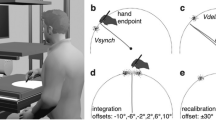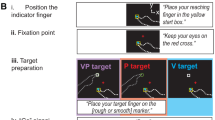Abstract
Two experiments examined the integration of visual and proprioceptive information concerning the location of an unseen hand, using a mirror positioned along the midsagittal plane. In experiment 1, participants tapped the fingers of both hands in synchrony, while viewing the mirror-reflection of their left hand. After 6 s, participants made reaching movements to a target with their unseen right hand behind the mirror. Reaches were accurate when visually and proprioceptively specified hand positions were congruent prior to the reach, but significantly biased by vision when the visual location conflicted with the real location. This effect was independent of the target location and depended strongly upon the relative position of the mirror-reflected hand. In experiment 2, participants made reaching movements following 4, 8, or 12 s active visuomotor or passive visual exposure to the mirror, or following passive exposure without the mirror. Reaching was biased more by the visual location following active visuomotor compared to passive visual exposure, and this bias increased with the duration of visual exposure. These results suggest that the felt position of the hand depends upon an integrated, weighted sum of visual and proprioceptive information. Visual information is weighted more strongly under active visuomotor than passive visual exposure, and with increasing exposure duration to the mirror reflected hand.



Similar content being viewed by others
References
Altschuler EL, Wisdom SB, Stone L, Foster C, Galasko D, Llewellyn DM, Ramachandran VS (1999) Rehabilitation of hemiparesis after stroke with a mirror. Lancet 353:2035–2036
Balslev D, Christensen LOD, Lee JH, Law I, Paulson OB, Miall RC (2004) Enhanced accuracy in novel mirror drawing after repetitive transcranial magnetic stimulation-induced proprioceptive deafferentation. J Neurosci 24:9698–9702
van Beers RJ, Sittig AC, Denier van der Gon JJ (1998) The precision of proprioceptive position sense. Exp Brain Res 122:367–377
van Beers RJ, Sittig AC, Denier van der Gon JJ (1999a) Integration of proprioceptive and visual position-information: an experimentally supported model. J Neurophysiol 81:1355–1364
van Beers RJ, Sittig AC, Denier van der Gon JJ (1999b) Localization of a seen finger is based exclusively on proprioception and on vision of the finger. Exp Brain Res 125:43–49
van Beers RJ, Wolpert DM, Haggard P (2002) When feeling is more important than seeing in sensorimotor adaptation. Curr Biol 12:834–837
Binkofski F, Buccino G, Dohle C, Seitz RJ, Freund H (1999) Mirror agnosia and mirror ataxia constitute different parietal lobe disorders. Ann Neurol 46:51–61
Brown LE, Rosenbaum CP, Sainburg RL (2003) Movement speed effects on limb position drift. Exp Brain Res 153:266–274
Burnett CT (1904) Studies in the influence of abnormal position upon the motor impulse. Psychol Rev 11:370–394
Canon LK (1970) Intermodality inconsistency of input and directed attention as determinants of the nature of adaptation. J Exp Psychol 84:141–147
Canon LK (1971) Directed attention and maladaptive “adaptation” to displacement of the visual field. J Exp Psychol 88:403–408
Chokron S, Colliot P, Atzeni T, Bartolomeo P, Ohlmann T (2004) Active versus passive proprioceptive straight-ahead pointing in normal subjects. Brain Cogn 55:290–294
Clower DM, Hoffmann JM, Votaw JR, Faber TL, Woods RP, Alexander GE (1996) Role of posterior parietal cortex in the recalibration of visually guided reaching. Nature 383:618–621
Desmurget M, Rossetti YKK, Prablanc C, Stelmach GE, Jeannerod M (1995) Representation of hand position prior to movement and motor variability. Can J Physiol Pharmacol 73:262–272
Desmurget M, Rossetti YKK, Jordan M, Meckler C, Prablanc C (1997) Viewing the hand prior to movement improves accuracy of pointing performed toward the unseen contralateral hand. Exp Brain Res 115:180–186
Efstathiou E (1969) Effects of exposure time and magnitude of prism transform on eye-hand coordination. J Exp Psychol 81:235–240
Ehrsson HH, Spence C, Passingham RE (2004) That’s my hand! Activity in premotor cortex reflects feeling of ownership of a limb. Science 305:875–877
Ernst MO, Banks MS (2002) Humans integrate visual and haptic information in a statistically optimal fashion. Nature 412:429–433
Ernst MO, Bülthoff HH (2004) Merging the senses into a robust percept. Trends Cogn Sci 8:162–169
Franz EA, Packman T (2004) Fooling the brain into thinking it sees both hands moving enhances bimanual spatial coupling. Exp Brain Res 157:174–180
Grafton ST, Mazziotta JC, Woods RP, Phelps ME (1992) Human functional anatomy of visually guided finger movements. Brain 115:565–587
Graziano MSA (1999) Where is my arm? The relative role of vision and proprioception in the neuronal representation of limb position. Proc Natl Acad Sci USA 96:10418–10421
Gregory RL (1996) Mirrors in mind. Freeman, New York
Haggard P, Newman CS, Blundell J, Andrew H (2000) The perceived position of the hand in space. Percept Psychophys 62:363–377
Harris CS (1965) Perceptual adaptation to inverted, reversed and displaced vision. Psychol Rev 72:419–444
Hay JC, Pick HL Jr, Ikeda K (1965) Visual capture produced by prism spectacles. Psychon Sci 2:215–216
Holmes NP, Spence C (2004) The body schema and multisensory representation(s) of peripersonal space. Cognit Proc 5:94–105
Holmes NP, Crozier G, Spence C (2004) When mirrors lie: “visual capture” of arm position impairs reaching performance. Cogn Affect Behav Neurosci 4:193–200
Jackson CV, Zangwill OL (1953) Experimental finger dyspraxia. Q J Exp Psychol 4:1–10
Kelso JAS, Cook E, Olson ME, Epstein W (1975) Allocation of attention and the locus of adaptation to displaced vision. J Exp Psychol Hum Percept Perform 1:237–245
Lajoie Y, Paillard J, Teasdale N, Bard C, Fleury M, Forget R, Lamarre Y (1992) Mirror drawing in a deafferented patient and normal subjects: visuoproprioceptive conflict. Neurology 42:1104–1106
Lateiner JE, Sainburg RL (2003) Differential contributions of vision and proprioception to movement accuracy. Exp Brain Res 151:446–454
Lloyd DM, Shore DI, Spence C, Calvert GA (2003) Multisensory representation of limb position in human premotor cortex. Nat Neurosci 6:17–18
Mon-Williams M, Wann JP, Jenkinson M, Rushton K (1997) Synaesthesia in the normal limb. Proc R Soc Lond B Biol Sci 264:1007–1010
Nielsen TI (1963) Volition: a new experimental approach. Scand J Psychol 4:225–230
Pick HL Jr, Warren DH, Hay JC (1969) Sensory conflict in judgments of spatial direction. Percept Psychophys 6:203–205
Plooy A, Tresilian JR, Mon-Williams M, Wann JP (1998) The contribution of vision and proprioception to judgements of finger proximity. Exp Brain Res 118:415–420
Ramachandran VS, Rogers-Ramachandran D, Cobb S (1995) Touching the phantom limb. Nature 377:489–490
Ramachandran VS, Rogers-Ramachandran D (1996) Synaesthesia in phantom limbs induced with mirrors. Proc R Soc Lond B Biol Sci 263:377–386
Ramachandran VS, Altschuler EL, Hillyer S (1997) Mirror agnosia. Proc R Soc Lond B Biol Sci 264:645–647
Ro T, Wallace R, Hagedorn JC, Farnè A, Pienkos E (2004) Visual enhancing of tactile perception in posterior parietal cortex. J Cogn Neurosci 16:24–30
Rossetti Y, Desmurget M, Prablanc C (1995) Vectorial coding of movement: vision, proprioception, or both? J Neurophys 74:457–463
Sathian K, Greenspan AI, Wolf SL (2000) Doing it with mirrors: a case study of a novel approach to neurorehabilitation. Neurorehabil Neural Repair 14:73–76
Shimojo S (1987) Attention-dependent visual capture in double vision. Perception 16:445–447
Smyrnis N, Gourtzelidis P, Evdokimidis I (2000) A systematic directional error in 2-D arm movements increases with increasing delay between visual target presentation and movement execution. Exp Brain Res 131:111–120
Wann JP, Ibrahim SF (1992) Does limb proprioception drift? Exp Brain Res 91:162–166
Welch RB (1971) Prism adaptation: the “target-pointing effect” as a function of exposure trials. Percept Psychophys 9:102–104
Welch RB (1972) The effect of experienced limb identity upon adaptation to simulated displacement of the visual field. Percept Psychophys 12:453–456
Welch RB, Widawski MH, Harrington J, Warren DH (1979) An examination of the relationship between visual capture and prism adaptation. Percept Psychophys 25:126–132
Wertheimer M, Arena AJ (1959) Effect of exposure time on adaptation to disarranged hand-eye coordination. Percept Mot Skills 9:159–164
Acknowledgements
N.P.H. was supported by a Wellcome Prize Studentship (number 065696/Z/01/A) from The Wellcome Trust.
Author information
Authors and Affiliations
Corresponding author
Rights and permissions
About this article
Cite this article
Holmes, N.P., Spence, C. Visual bias of unseen hand position with a mirror: spatial and temporal factors. Exp Brain Res 166, 489–497 (2005). https://doi.org/10.1007/s00221-005-2389-4
Received:
Accepted:
Published:
Issue Date:
DOI: https://doi.org/10.1007/s00221-005-2389-4




